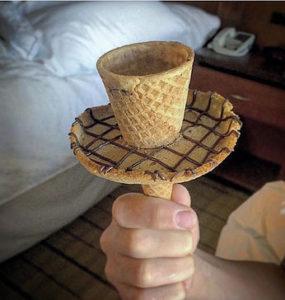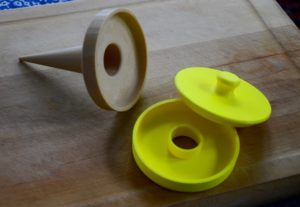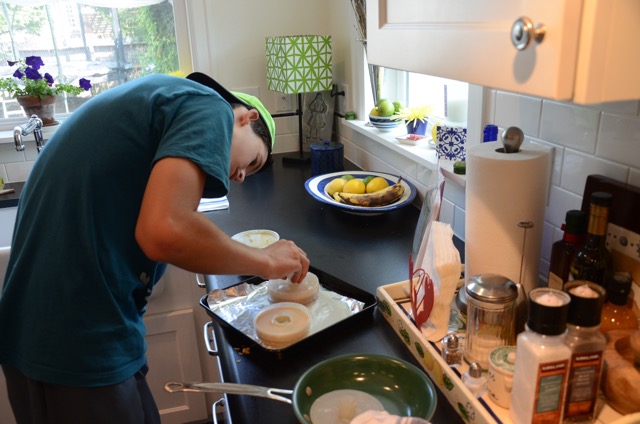Shark Tank: High School Students Win $50,000 for Brilliant Ice Cream Cone Device, with Help from The 3D Printing Store
There’s nothing like an ice cream cone on a summer day, is there? Except for that one pesky factor – the melting. It doesn’t take long for a scoop of frosty, creamy goodness to turn into a river of sticky nastiness running down your arm or dripping onto the ground as you frantically speed-lick to try and catch some of it before it all turns into a soggy mess. I’m an easily grossed-out person, so I hadn’t even reached adulthood before I decided I wasn’t dealing with it anymore and just started ordering my ice cream in a bowl.
Of course, that means that I haven’t had a delicious, crunchy waffle cone in ages, but that’s the tradeoff, I suppose. A couple of students, however, have come up with an idea for ice cream fans to have the best of both worlds. The Drip Drop is the invention of Sam Nassif and Oliver Greenwald, who were only ten years old when they entered the Gates Invention and Innovation Competition, which challenges kids to design products that solve practical problems or improve daily life. While thinking about what they could invent for the competition, the then-fifth-grade boys walked past an ice cream shop and saw a woman struggling to clean up her two ice cream-coated children with a handful of napkins.
 Nassif and Greenwald had their concept then. After some brainstorming, they came up with the Drip Drop – a saucerlike ring that slides over an ice cream cone to catch the drips from melting ice cream. The ring would be made from the same material as the cone, making it a zero-waste solution, and the Gates Competition judges liked it so much that they awarded the boys funding for a patent attorney. In April 2015, they were awarded a US Design Patent for the invention, with two additional patents pending.
Nassif and Greenwald had their concept then. After some brainstorming, they came up with the Drip Drop – a saucerlike ring that slides over an ice cream cone to catch the drips from melting ice cream. The ring would be made from the same material as the cone, making it a zero-waste solution, and the Gates Competition judges liked it so much that they awarded the boys funding for a patent attorney. In April 2015, they were awarded a US Design Patent for the invention, with two additional patents pending.
One year after that, Nassif and Greenwald were selected out of 50,000 applicants to pitch their idea on the ABC show Shark Tank. To demonstrate their idea, they would need an actual product model. The boys had previously created models out of clay, as well as printing a few designs on their school’s 3D printer, but they weren’t satisfied; they needed more professional resources, so they turned to The 3D Printing Store.
Within a day, The 3D Printing Store worked up a design and 3D printed a model of the Drip Drop, but Nassif and Greenwald wanted to take the product to the next level and actually create waffle cones with their design. The 3D Printing Store suggested creating a mold from a food-safe material in which waffle batter could be poured and baked. The boys went out and bought the necessary materials, then used the 3D printed model to cast a food-safe, oven-safe mold.
It took a lot of trial and error to get the perfect combination of ingredients for their ringed cone, but once they perfected the mold and the cone, they presented the idea to Shark Tank:
Nassif and Greenwald, now in 9th grade and the youngest applicants to ever pitch their idea on Shark Tank without adult accompaniment, were awarded a $50,000 investment. Their next step is to license the invention to ice cream shops everywhere in hopes of preserving the environment through reduced need for napkins, bowls and spoons – and improving the ice cream cone-eating experience for kids and adults alike. Discuss further over in the Drip Drop Gets Help from 3D Printing Store forum at 3DPB.com.
[Source/Images: Drip Drop / The 3D Printing Store]Subscribe to Our Email Newsletter
Stay up-to-date on all the latest news from the 3D printing industry and receive information and offers from third party vendors.
You May Also Like
Model No. Deploys Titan Pellet 3D Printers for Sustainable Furniture Production
Over the years, many designers have tried to create 3D printed polymer furniture. Early pioneers like Janne Kyttanen, Materialise’s MGX, and Joris Laarman have led the way with 3D printed...
3D Printing News Unpeeled: Recycling PLA, More Efficient Atomizing
Filamentive hopes to recycle your PLA if you’re in the UK and order over £500 worth of filament. Their partner 3D Printing Waste (3DPW) will turn the PLA into injection...
Lighting the Way with Potato Starch: Sustainable Polish ECO Lamps Use 3D Printing
Lighting that meets the essence of nature: this is the reality brought to life by ECO Lamps, which introduces a fresh perspective to sustainable lighting design using potato starch. These...
3D Printing News Unpeeled: 3D Printed Construction Standard, Sand Wall & Self Heating Microfluidics
ISO/ASTM Standard 52939:2023 has been released and it sets standards for QA for 3D Printed polymer, composite and cement buildings. This is most welcome since 3D printed construction is a...



































